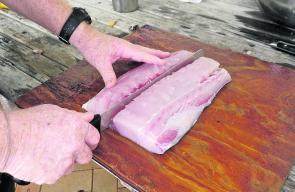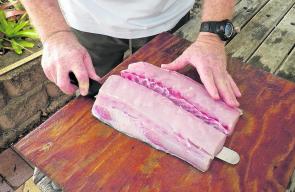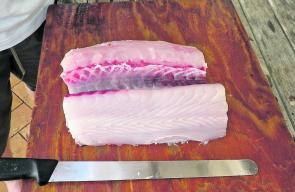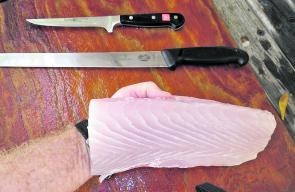Mackerel is a great fish to catch and eat, but one of the big challenges with this species is skinning the fillet. Filleting mackerel has pretty well become the norm from the days of slicing the whole body crossways into steaks. The flesh stays moist and offers a lot more cooking options to the age-old mackerel steak.
Lynn Bain, QFM’s ‘Iron Chef’, wrote a great feature on filleting mackerel, titled 'Filleting long slender fish', which ran in the September 2012 issue of the magazine. The link to Lynn’s article on the Fishing Monthly website is http://www.fishingmonthly.com.au/Articles/Display/13581-Filleting-long-slender-fish.
The two issues faced when skinning mackerel are; the skin is so soft that it is extremely easy to cut though by accident due to the lack of scales, and the bloodline gives the flesh a much stronger smell when cooking and flavour when eating it. My wife can’t stand fishy smells when cooking strong flavoured fish or any sign of bloodline, so it has always been a challenge to process fish that will make it into her kitchen.
My brother-in–law came to the rescue one day when he mentioned a great new method he had learned from a neighbour and fishing buddy in Bundaberg. I was onto it in a flash and the very next mackerel that made it to my filleting table got the new skinning treatment. It worked a treat and I have been skinning mackerel this way ever since, and putting the word out to all my fishing buddies.
Firstly, fillet the mackerel either using Lynn’s method or any other that gives you two large, long, fillets per fish. Lay the fillet longways in front of you with the skin down and cut it perpendicular to the lateral line in whatever lengths suit your purpose. I like pieces around 25cm, as they fit nicely into the 28cm vacuum-sealed, food saver bags or cut rolls. You will need a knife with a blade that has a straight cutting edge at least the length of the cut pieces. My ideal skinning knife is a ham-slicing knife, stocked by some tackle stores and most specialist knife stores like King of Knives.
Place the cut section in front of you with the lateral line perpendicular to your shoulders and carefully position the skinning knife just to the right of the centreline of the cut fillet. Your left hand holds the fillet still on the left side of the blade. Cut down and slightly out to the right, increasing the angle of the blade, as you get closer to the skin. This cutting action will follow the bloodline down. By the time the blade gets to the skin, the cutting edge is about a third of the way to the outside edge of the fillet. Continue laying the blade over until it is parallel with the skin and cut right out through the fillet, close to the skin. You will be left with a beautiful clean slab of mackerel flesh, with no bone, skin or bloodline.
Turn the cut fillet around and repeat the operation on the other side of the bloodline. The fillet is often harder to hold with one side of flesh already removed, so a fork can be used, instead of fingers, to hold the skinned side of the fillet steady while skinning the other side. The left over bloodline and skin makes great berley, or can be used as reef fishing bait if desired.
Reads: 4249
Position the skinning knife just to the right of the centreline of the cut fillet.

Cut down and slightly out to the right, increasing the angle of the blade, as you get closer to the skin.

Continue laying the blade over until it is parallel with the skin.

Cut right out through the fillet, close to the skin.

You will be left with a beautiful clean slab of mackerel flesh, with no bone, skin or bloodline.




